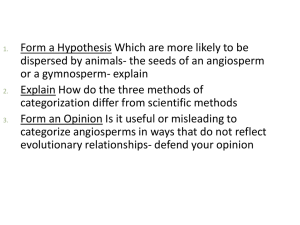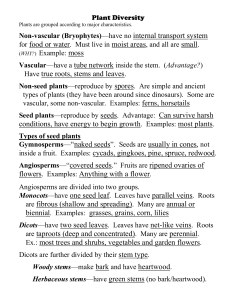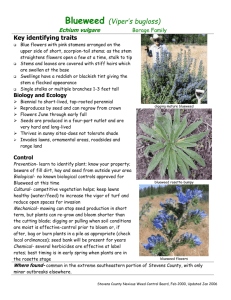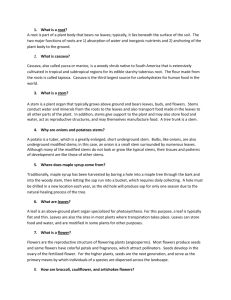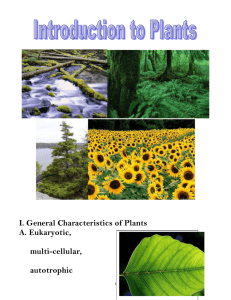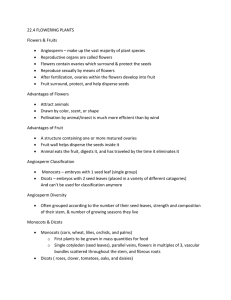Abies procera Noble fir Pinaceae ABPR
advertisement
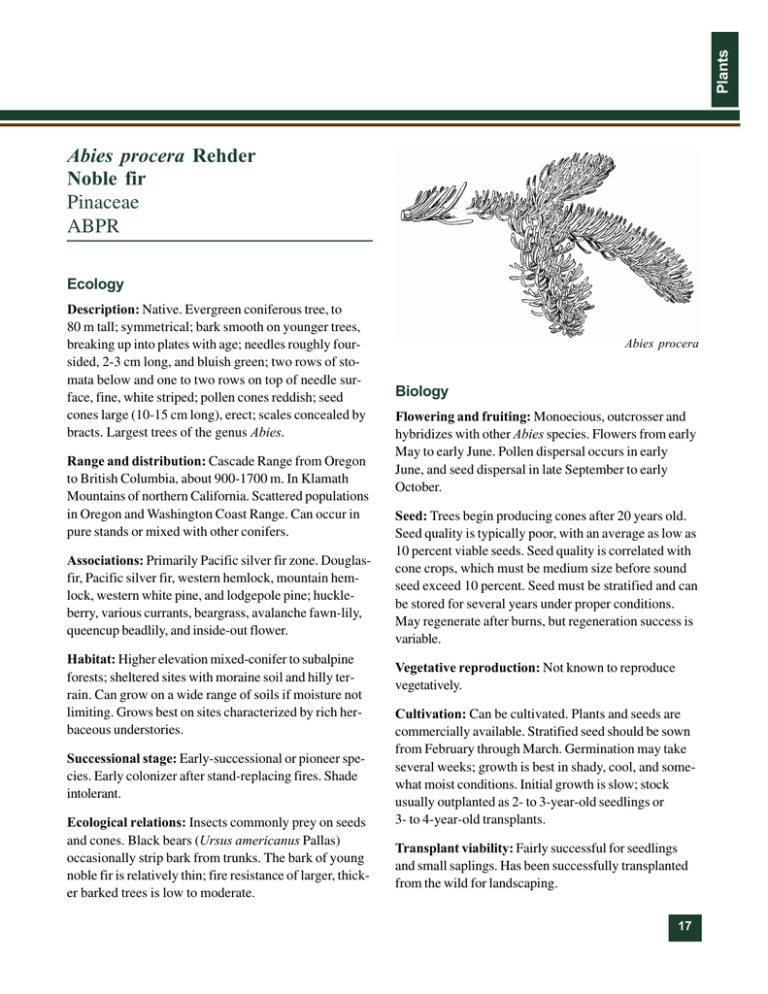
Plants Abies procera Rehder Noble fir Pinaceae ABPR Ecology Description: Native. Evergreen coniferous tree, to 80 m tall; symmetrical; bark smooth on younger trees, breaking up into plates with age; needles roughly foursided, 2-3 cm long, and bluish green; two rows of stomata below and one to two rows on top of needle surface, fine, white striped; pollen cones reddish; seed cones large (10-15 cm long), erect; scales concealed by bracts. Largest trees of the genus Abies. Range and distribution: Cascade Range from Oregon to British Columbia, about 900-1700 m. In Klamath Mountains of northern California. Scattered populations in Oregon and Washington Coast Range. Can occur in pure stands or mixed with other conifers. Associations: Primarily Pacific silver fir zone. Douglasfir, Pacific silver fir, western hemlock, mountain hemlock, western white pine, and lodgepole pine; huckleberry, various currants, beargrass, avalanche fawn-lily, queencup beadlily, and inside-out flower. Habitat: Higher elevation mixed-conifer to subalpine forests; sheltered sites with moraine soil and hilly terrain. Can grow on a wide range of soils if moisture not limiting. Grows best on sites characterized by rich herbaceous understories. Successional stage: Early-successional or pioneer species. Early colonizer after stand-replacing fires. Shade intolerant. Ecological relations: Insects commonly prey on seeds and cones. Black bears (Ursus americanus Pallas) occasionally strip bark from trunks. The bark of young noble fir is relatively thin; fire resistance of larger, thicker barked trees is low to moderate. Abies procera Biology Flowering and fruiting: Monoecious, outcrosser and hybridizes with other Abies species. Flowers from early May to early June. Pollen dispersal occurs in early June, and seed dispersal in late September to early October. Seed: Trees begin producing cones after 20 years old. Seed quality is typically poor, with an average as low as 10 percent viable seeds. Seed quality is correlated with cone crops, which must be medium size before sound seed exceed 10 percent. Seed must be stratified and can be stored for several years under proper conditions. May regenerate after burns, but regeneration success is variable. Vegetative reproduction: Not known to reproduce vegetatively. Cultivation: Can be cultivated. Plants and seeds are commercially available. Stratified seed should be sown from February through March. Germination may take several weeks; growth is best in shady, cool, and somewhat moist conditions. Initial growth is slow; stock usually outplanted as 2- to 3-year-old seedlings or 3- to 4-year-old transplants. Transplant viability: Fairly successful for seedlings and small saplings. Has been successfully transplanted from the wild for landscaping. 17 Plants Collection Uses and Products Part harvested: Branches, boughs, and cones. Entire tree can be harvested for timber or Christmas trees. Overstocked trees can be harvested when less than 3 m tall for landscape industry. Common uses: Floral. Christmas trees, decorative boughs; wood is valued for specialty products because of its high strength-to-weight ratio. Also used for ornamental planting and landscaping. Harvest techniques: Branches selected from trees generally less than 18 m tall for blue-green to dark green color, desirable form, symmetry, and needle curl. Standing on the ground, the harvester cuts the boughs with strong clippers or pole pruners generally leaving lateral branches closest to main bole. The boughs selected are free of disease, insects, dirt, and broken or damaged needles. All needles should be dark green and firmly attached. Branches are kept cool during transport and storage to prevent desiccation. Branches higher on the bole are generally of better quality, have needles of better color, and are curved and have less damage. Tree branches can be reclipped after several years when lateral branches have grown sufficiently to produce a harvestable bough. Cones should be collected before they open as they disintegrate quickly. Indigenous uses: Bark of fir trees used to tan leather. Paiute used dried foliage as cold remedy and decoction of leaves for cough medicine. Harvest season: Fall to winter, ideally when autumn precipitation and cooler temperatures are occurring. Christmas greens are purchased from the second week of September through the first week of December by the largest buyers. Boughs are harvested after foliage has hardened off. This usually follows a hard frost in September. Intergrades with Shasta red fir. Noble fir was introduced into Denmark in the mid 19th century and is now common throughout the country. Boughs are harvested commercially for decorative uses in Scandinavian countries. Noble fir young enough for bough harvest has been reported to be decreasing in wild stands. Regeneration after harvest: Uncut lateral branches are stimulated to grow after harvest of branch terminal in younger trees and can be reharvested after several years. Shaded branches lower on the bole have poorer regeneration capacity. References 18 Common products: Branches: Christmas decorations, wreathes, and decorative greens; tree: specialty wood, plywood, and Christmas trees. Types of markets: Christmas greens and trees, floral crafts, landscaping, and timber. Domestic and international markets for Christmas trees, finished holiday greenery products, bulk holiday greenery, floral, and crafts. Domestic markets for landscaping and specialty lumber. Comments and Areas of Concern Burns and Honkala (1990), Cope (1993), Danish Forest Sales Catalogue (n.d.), Franklin (1974), Hickman (1993), Hortus West (1998), Moerman (1998a), Pojar and MacKinnon (1994), USDA Forest Service (1963), Young and Young (1992) Plants Acer circinatum Pursh Vine maple Aceraceae ACCI Ecology Description: Native. Shrub or small tree, to 7 m, sprawling branches often rooting and forming new colonies; assumes erect, treelike form in clearings; diameter to 20 cm; bark gray or brown, smooth or finely fissured; stems pale green, becoming dull brown; leaves, opposite, deciduous, palmately lobed, 5-12 cm across, 3-6 cm long, seven to nine lobes, toothed, and hairy; dense inflorescence, 4 to 10 flowers, purple sepals, white petals, 6-9 mm broad, in clusters at end of shoots; winged fruits (samaras), 2-4 cm green, becoming reddish brown, widely spreading. Autumn leaves vary from yellow (in the shade) to shades of red (in open sun). Range and distribution: Alaska to northern California, coast to the east side of the Cascade Range; low to middle elevations (1500 m). May form dense stands when growing in the shade. Associations: Pacific silver fir, western hemlock, Sitka spruce zones. Douglas-fir, grand fir, western hazel, dwarf Oregon grape, salal, trailing blackberry, western sword fern, and twinflower. Habitat: Shaded streambanks; moist to wet welldrained sites; generally under other trees but sometimes in forest openings, open ridges, or talus slopes. In the transition zone between wetland and upland where soils are moist but not saturated for long periods. Successional stage: From early- through late-successional stages, most frequent in mid-successional forests. Moderately shade tolerant; grows in canopy gaps. Acer circinatum elk and deer; seeds, buds, and flowers food for birds and small mammals; abundant pollen and nectar high in sugar content important to bees; nest material; cover; bank stabilization; buffer from wetland intrusion. Well adapted to fire; sprouts from the root crown after disturbance. Biology Flowering and fruiting: Flowers from April through June, fruits (samaras) ripen from September through October, and dispersed through November. Ecological relations: Wildlife value high. Browse for 19 Plants Seed: Poor seed producer, small quantities produced annually; dispersed in fall, germinate in spring. Bare mineral soil required for natural seed germination. Samaras collected when wings are green. Seed should not be allowed to dry. Seeds require a cold, moist stratification; mechanical rupture of pericarp may aid germination. Vegetative reproduction: Natural regeneration primarily by layering shaded forests. Cuttings difficult to root; propagation by layering slow. Cultivation: Can be cultivated. Plants and seeds are commercially available. Seeds should be sown in fall in mulched beds. Shade is important during seedling establishment. Seedlings can be transplanted as 2-year-old stock. Four recognized cultivars developed for ornamentation. Grows best in slightly acidic soil with abundance of organic material. Transplant viability: Seedlings growing around a dense patch of vine maple, if not flowering or leafed out, may be dug up and potted immediately, well into spring. Collection Part harvested: Branches, stems, whole plant, and seeds. Harvest techniques: Seeds are collected by hand or by shaking on tarp. Branches and stems are clipped with pruners. Whole plants are dug up as young saplings up to 1 m in height. (Note: widely available from nurseries.) Harvest season: Seed collection in September and October. Stem, branches clipped preferably when buds dormant. Branches best harvested when dormant but can be harvested year-round. Whole plant is harvested from late fall until spring bud break. Transplants are taken in fall or early spring in cool, damp weather. Regeneration after harvest: If a small proportion of branches are clipped, regeneration is good. 20 Uses and Products Common uses: Fresh and dried floral and greenery and ornamental silk trees; used locally for tool handles, firewood, roundwood furniture, and home decoration crafting. Indigenous uses: Snowshoe frames, drum hoops, small implements, baskets, salmon scoop nets, bows, and wood for smoking fish or fowl. Common products: Silk tree stems and indoor ornamental plants. Native landscape or restoration plants, traditional crafts, baskets and furniture, home interior decorations, dried flower arrangements. Types of markets: Floral (silk trees), crafts, and landscaping. International and domestic markets for floral, silk tree stocks, specialty wood and finished traditional crafts. Domestic markets for native landscape plants, restoration plantings, and specialty furniture. Comments and Areas of Concern The tree grows to its largest size in older second-growth and mature Pacific coastal forests. Vine maple stems provide important habitat for many bryophytic species (mosses, liverworts, and lichens) and associated organisms. They should not be harvested when heavily occupied by bryophytes and associates. Because of wide adaptability and fibrous root system, vine maple is used for reclamation, restoration, and erosion control. References Burgett et al. (1989), Cooke (1997), Flessner et al. (1992), Hickman (1993), Hitchcock and Cronquist (1978), Hortus West (1998), Kruckeberg (1993), Olson and Gabriel (1974), Pojar and MacKinnon (1994), Rose et al. (1998), Sudworth (1967), Thomas and Schumann (1993), Uchytil (1989), USDA Forest Service (1988), Vance and Kirkland (1997), Whitney (1997) Plants Achillea millefolium L. Common yarrow, yarrow Asteraceae ACMI2 Ecology Description: Native and exotic. Perennial herb; 10-100 cm; erect stems; alternate, fernlike leaves, 3-15 cm long; umbel inflorescence, flat or round topped cluster; flower head, both ray and disk flowers; ray flowers usually five, 2-4 mm long, white to pink or reddish; disk flowers 10 to 30, cream color; fruits hairless flattened achenes. Name translates to “thousand flowers.” Range and distribution: Common throughout North America, from sea level to above timberline, but generally at elevations of 1200-3350 m. Widely distributed and scattered across open habitats. Associations: Mixed dry forest types, brushfield, tall forb prairie, and grassland plant communities. Ponderosa pine, Douglas-fir, grand fir, snowberry, bitter-brush, groundsel, bluebunch wheatgrass, and fescues. Habitat: Open forest, dry meadows, brushlands, prairie, overgrazed grasslands, and open disturbed environments such as roadsides and vacant lots. Successional stage: Early-successional species, often in disturbed sites, roadcuts, etc. Shade intolerant. Ecological relations: This aromatic herb is generally unpalatable to animals, but flower heads may be grazed by sheep, pronghorn, and deer. Pungency repels many insects yet attracts others, thereby resulting in maintenance of biodiversity. Good soil binder, used in erosion control because of extensive rhizomes. Yarrow is usually undamaged or only slightly damaged by fires of any intensity. Severe fires that burn into the soil, however, may damage rhizomes. Regeneration after fire is from rhizomes and airborne seeds that spread from adjacent sites. Because of extensive rhizome sprouting, yarrow Achillea millefolium usually increases immediately in density, frequency, and cover for at least the first few years after a fire. Often an indicator of past overstocking and excessive utilization. Biology Flowering and fruiting: Flowers in April, at lower elevations, through September, at higher elevations; fruiting occurs from August through September. Seed: Seeds are persistent and generally abundant. When flower heads turn brown, the seed is mature and ready to be collected. Germination requires light and moderate temperatures. 21 Plants Vegetative reproduction: Can be propagated by sprigs divided from parent plant and rhizomes. Cultivation: Widely cultivated. Plants and seeds are commercially available. Transplant viability: Good; regenerates naturally via rhizomes. Collection Part harvested: Leaves, stems, and flowers. Harvest techniques: Inflorescences differ and tend to be larger in wetter more productive sites. Flowers and leaves are collected by using sharp clippers to clip stem during flowering; some stem and leaves of mature plant should be left. Harvest season: Generally during blooming period. Regeneration after harvest: Plant responds to clipping by producing more shoots. Uses and Products Common uses: Flowers, leaves, and stems: anti-inflammatory, styptic, astringent, and acute fever-reducer. European phytomedicine herb for fever and colds, and menstrual cramps. Skin and hair tonic: antidandruff, facial steams; food seasoning, bitters, vermouths, and beer. Dried flowers: summer and winter bouquets. Whole plant: erosion control and xeric landscaping. Indigenous uses: Used to treat colds, fevers, anorexia, indigestion, gastric inflammations, and internal bleeding. Fresh herb used as a styptic poultice, expectorant analgesic, and sweat inducer. Used to treat ear, tooth, and headaches. Common products: Teas, tinctures, decorative, smoking mixtures, and food additive; landscape plant. 22 Types of markets: International and domestic. Medicinal, pharmaceutical, herbal, floral; regional, nursery, restoration. Comments and Areas of Concern May cause dermatitis; not recommended for use during pregnancy. Herbicides often are used in roadsides and areas where yarrow is common. Yarrow is traditionally used by Native American tribes, and Alaska Natives have requested limited commercial use. Often grows on unstable slopes and roadcuts; should not be collected if there is risk of increase in slope instability and erosion potential. References Duke (1997), Everett (1997), Foster and Duke (1990), Franklin and Dyrness (1973), Hickerson (1986), Hickman (1993), Hitchcock and Cronquist (1978), Hortus West (1998), Leung and Foster (1996), Mizerak (1998), Moore (1993), Pojar and MacKinnon (1994), Rose et al. (1998), Ross and Chambers (1988), Seda (1989), Tilford (1998), USDA ARS (2000), USDA NRCS (1999), Young and Young (1986) Plants Anaphalis margaritacea (L.) Benth. Pearly everlasting Asteraceae ANMA Ecology Description: Native. Perennial herb from rhizomes; multiple unbranched leafy stems; 20-100 cm; alternate leaves, narrow lance shaped, 5-15 cm; umbel inflorescence, heads in dense, flat-topped clusters; flowers are yellow disks surrounded by dry, pearly white involucral bracts; fruit small, rough, hairless to sparsely hairy achenes. Range and distribution: Common and widespread, from low to subalpine elevation, California through Alaska to east coast, and most of northern and central United States. May grow in dense patches. Associations: Mixed forest types, brushfield shrubs and herbs, bracken fern, common yarrow, fireweed, and grasses such as red fescue. Habitat: Rocky slopes, semidry open forest, clearings, meadows, fields, roadsides, burned-over and cut-over areas. Successional stage: Early successional; responds favorably to disturbance; has invasive characteristics. Shade tolerant. Anaphalis margaritacea Seed: Matures from July to September, wide seed dispersal, carried long distances by hairs on seeds, difficult to separate from the fluffy chaff. Seeds germinate easily. Ecological relations: Larval food for American lady butterfly (Vanessa virginiensis Drury); used by bees attracted to nearby growing fireweed. Vegetative reproduction: Easy to propagate from pieces of rhizome. Biology Transplant viability: Can be dug up, divided, and replanted when the clumps become too dense. Best time to transplant is spring or fall. Flowering and fruiting: Flowers from June through August. Cultivation: Can be cultivated. Plants and seeds are commercially available. 23 Plants Collection Comments and Areas of Concern Part harvested: Aerial part of stem with leaves and inflorescence. Considered a range weed; unpalatable to livestock. May be a good candidate for restoration following fire and other major disturbance on erosive sites. Harvest techniques: The herb is harvested by clipping stem well above root crown. Harvest season: When flowering is at its peak for dried flowers and into late summer for herbal use. Regeneration after harvest: Once inflorescence is harvested, it does not produce new flowering stems the same season. Uses and Products Common uses: Floral arrangements. Dried pearly everlasting used to make long-lasting bouquets and decorations. Infusion or teas for astringent and antiinflammatory properties, for soothing irritable stomach. Leaf and flower poultice for bruises and sunburn. Indigenous uses: Influenza medicine, poultice of boiled leaves applied to burns, plants used for tuberculosis, colds, and sore throat. Infusion of flower used as an herbal steam for rheumatism and paralysis. Roots and stalks used for diarrhea and dysentery. Also a hand softener and smoking herb. Common products: Dried floral decoratives, herbal teas, and ingredient in personal care products. Types of markets: Primarily domestic. Floral, herbal, and personal care. 24 References Burgett et al. (1989), Franklin and Dyrness (1973), Hickman (1993), Hortus West (1998), Kruckeberg (1993), MacFarlane (1985), Moore (1993), Munz and Keck (1959), Pojar and MacKinnon (1994), Rose et al. (1998), USDA Forest Service (1988), USDA ARS (2000), USDA NRCS (1999), Whitney (1997) Plants Angelica L. spp. Angelica Apiaceae ANGEL A. genuflexa Nutt., Kneeling angelica- ANGE2 A. arguta Nutt., Lyall’s angelica- ANAR3 A. arguta Ecology Description: Native. Angelica genuflexa: stout perennial from taproot, inside root usually solid; stem leafy, hairless, hollow, arising from erect, tuberous, chambered stem base; stem 1-1.5 m, often purplish and glaucous; leaves compound, 4-10 cm long, with three major divisions, primary divisions bent back; leaf stalk bent above the first pair of primary leaflets; ultimate leaflets egg- to lance-shaped, coarsely toothed; veins tending to end at the points of the teeth; leaf stalks with inflated bases sheathing the main stem; flowers white or pinkish, small in numerous compact heads arranged in several umbrella-shaped clusters, more than 20 per umbel; involucral bracts lacking; fruits rounded, 3-4 mm, broadly winged lateral ribs. Angelica arguta similar but does not have bent leaves and leaf stalks. Range and distribution: Angelica genuflexa: common at low to middle elevations in northern two-thirds of region, sporadic southwards in Washington and Oregon, Klamath Mountains and northern California coast; A. arguta: scattered from southernmost British Columbia to California, more common in Oregon. Angelica genuflexa forms large mats; A. arguta in high elevation in dispersed stands. Associations: Mountain hemlock, Pacific silver fir, western hemlock zones. Red alder, thimbleberry, lady fern, Sitka valerian, sedges, cow-parsnip, stinging nettle, and common horsetail. Habitat: Moist thickets, forest openings, swamps, streambanks, wet ditches and clearings, and flooded or ponded marshes. Angelica genuflexa Successional stage: Part of stable plant communities but also populates openings or canopy gaps. Moderately shade tolerant. Ecological relations: Habitat for ground-nesting birds and mammals, concealment; pollinator attractor; rapid decomposer contributes substantially to soil structure. Biology Flowering and fruiting: Blooms from July through August. Seed: Angelica is a perennial that may require two or more seasons to produce seed. Seeds require cold stratification to germinate. Vegetative reproduction: Unknown. Cultivation: Can be cultivated from seed. Plants are commercially available for species sea-watch (Angelica lucida). Transplant viability: Not known; probably more reliable to start from seed. 25 Plants Collection Comments and Areas of Concern Part harvested: Root and seeds. Similar in appearance to poisonous Douglas’ waterhemlock (Cicuta douglasii); be certain of identification. Riparian soils compact easily. Riparian areas and streambanks susceptible to human disturbance. Native Americans use Angelica for spiritual and cultural purposes. Precautions should be taken that the patch being harvested is not a Native American gathering site. Encourage cultivation of this plant rather than wildcrafting. Angelica polymorpha, primary source of Dong Quai, an important Chinese herbal medicine, interbreeds with A. genuflexa. Harvest techniques: Seeds are collected before they fall off, preferably when slightly green. Only mature roots are collected. Size is checked by gently brushing away soil. Unharvested parts of plant are left for mulch. Most of the plants in a patch are left. Roots are collected only from plants growing in areas that will not be sensitive to digging. Harvest season: Seeds are gathered as late in season as possible, late summer to early fall after seeds have ripened. Roots are gathered in late summer to early fall. Positive identification is more difficult after the seeds have completely gone. Regeneration after harvest: Gathering roots generally kills the plant. Uses and Products Common uses: Seeds: upset stomach. Roots: medicinal, tea, tinctures for menstrual regulation, expectorant, to induce sweating, antibacterial, antifungal, antispasmodic, and diuretic. Now angelica root rarely used as a pharmaceutical preparation; fragrance ingredient in soaps, detergent, creams, lotions, perfumes; flavor ingredient in most major categories of food products; beverages, baked goods, etc. Indigenous uses: Spiritual uses, medicine, cathartic, analgesic, headache, intestinal cramps; cooking tools; soap and fragrance; spice; stems as underwater breathing tubes. Common products: Tea, tinctures, food and beverage additive, fragrance, herbals. Types of markets: International and domestic. Herbal, medicinal, food additives, and fragrances. 26 References Cooke (1997), Hortus West (1998), Leung and Foster (1996), Moerman (1998b), Moore (1993), Pojar and MacKinnon (1994), Tilford (1993, 1998) Plants Aralia californica S. Wats. California spikenard, spikenard Araliaceae ARCA2 Ecology Description: Native. Perennial shrub; erect stem 2-3 m; one to three large pinnately compound leaves, 1-2 m; umbels in clusters of two or in spreading panicle; yellowgreen flowers in panicles; fruits, blue-black berries in globose clusters. Range and distribution: Below 1800 m, southern Oregon to the Sierras and along the California coast. Grows in patches within its range. Associations: Western hemlock, mixed-conifer zones. Common associations in riparian plant communities; Douglas-fir, tanoak, Oregon ash, alder, big-leaf maple, sweet-cicely, bedstraw, and willow. Habitat: Mixed forest type; moist, shady areas; creeks, streams, and canyons. Successional stage: Mid to late successional. Shade tolerant. Ecological relations: Streambank stabilizer. Aralia californica Cultivation: Can be cultivated. Plants are commercially available. Transplant viability: Unknown. Biology Flowering and fruiting: Flowers from June through August, fruits August through October. Seed: Seeds small (4 mm wide). Fruits are collected in late summer. Ferment berries to get viable seed. Berries are black when seed is mature and ready to harvest. Can be propagated from seed; seed needs stratification to germinate. Vegetative reproduction: Sprouts easily from root division. Vegetative reproduction by roots. Cuttings root best in early to mid winter. Collection Part harvested: Root, berries for seed, and occasionally leaves. Harvest techniques: Center portion of root is cut out, leaving the crown and outer nodes in the ground to resprout. Harvest season: The root is collected in winter or late fall, after the plant has seeded (berries collected after ripe, late September to October). 27 Plants Regeneration after harvest: Roots regenerate after harvest, but sustainable harvest intervals have not been determined. Uses and Products Comments and Areas of Concern Grows in fragile riparian areas; banks are sensitive to erosion after roots are removed. Spikenard is a soughtafter source of ginsenglike products resulting in increasing harvest pressure; on United Plant Savers North American medicinal plants “To Watch” list. Common uses: Roots: tonic and lung expectorant; whole plant: garden landscaping. Indigenous uses: Decoction of roots used as a soak for arthritis, consumption, colds, fevers, lung and stomach diseases, and as a wash for itching sores. Common products: Tinctures, dried herbal products such as capsules, powders, and teas. Supplement to American ginseng products. Types of markets: International and domestic. Herbal and nutraceutical. 28 References Blakley (1997), Dyrness et al. (1974), Hickman (1993), Hortus West (1998), Kruckeberg (1993), Mizerak (1998), Moore (1993), Munz and Keck (1959), Rolle (1997), United Plant Savers (2000) Plants Arctostaphylos Adans. spp. Manzanita Ericaceae ARCTO3 A. columbiana Piper, Hairy manzanita-ARCO3 A. nevadensis Gray, Pinemat manzanita-ARNE A. patula Greene, Greenleaf manzanita-ARPA6 A. viscida Parry, White-leaved manzanita-ARVI4 Ecology Description: Native. Includes about 50 species, mostly evergreen, ranging from small mat-forming shrubs to small trees up to 10 m; prostrate to erect stems; fireresistant burl sometimes present at base; bark generally reddish, smooth or gray, rough and shredded; leathery, alternate leaves, spoon to lance shaped, spreading to ascending; inflorescence panicle or racemose clusters; urn-shaped flowers, white to pink; blackish-red, berrylike fruit 6-8 mm. Range and distribution: British Columbia south to northern California. Arctostaphylos columbiana: British Columbia to western Cascade Range south to northwestern California. Arctostaphylos patula and A. nevadensis: Washington south to California, east to Idaho (A. nevadensis), east to Colorado (A. patula). Arctostaphylos viscida: Southern Oregon to northern California east to Sierra Nevada Range. Elevations from 60-2200 m. Widespread; some species form dense stands. Associations: Western hemlock, mixed-conifer zones. Douglas-fir, white fir, ponderosa pine; oak, chaparral, brushfield, and nonforest communities; Pacific rhododendron, ceanothus, groundsel, lupine, and bracken fern. Habitat: Foothills to high montane, semidry to dry, open sites, well drained, rocky slopes or rock outcrops on slightly acidic soil. Arctostaphylos patula A. columbiana A. nevadensis Successional stage: Early to mid successional; responds favorably to mild to moderate fire. Low to moderate shade tolerance. Ecological relations: Berries eaten and dispersed by wildlife; deer and elk make some use of foliage in fall and winter. Source of nectar for native pollinators; major nectar source in the Rogue River valley and south coast. Important watershed cover and erosion control. Although fire kills aboveground portion of plant, may grow back from root crown or regenerate by fire-stimulated germination of dormant seeds stored in the soil. The plant has several characteristics related to fire intensity including shedding of bark and leaves, plant dieback during droughts, and formation of dense stands. Biology Flowering and fruiting: Small flowers bloom in early winter to spring; fruits ripen from summer to fall. Seed: Seeds usually have hard seed coats and dormant embryos so dormancy-breaking treatments are necessary. Vegetative reproduction: Can be propagated by rooted cuttings. 29 Plants Cultivation: Can be cultivated. Plants and seeds are commercially available. Transplant viability: Seedlings collected in the wild can be transplanted. Comments and Areas of Concern Manzanita protected by California law. Used in site restoration and slope stabilization within its natural range. Manzanita species have a high degree of hybridization. Gasquet manzanita (A. hispidula) found in the Siskiyou region of southern Oregon and globally listed. Collection Part harvested: Leaves, branches, flowers, and berries. References Harvest techniques: Branches are pruned off on larger bushes that may need thinning. If shrub is not to be destroyed, branches with leaves on stems are carefully selected and clipped leaving most leafy branches on shrub. Burg (1974), Burgett et al. (1989), Everett (1997), Franklin and Dyrness (1973), Hall (1988), Hickman (1993), Hitchcock and Cronquist (1978), Hortus West (1998), Howard (1992a), Kruckeberg (1993), Mizerak (1998), Oosting (1958), Pojar and MacKinnon (1994), Steinfeld (1996), Thomas and Schumann (1993), Tilford (1998), USDA Forest Service (1988), Whitney (1997), Young and Young (1986, 1992) Harvest season: Once the new growth is hardened off. Late summer, early fall until new growth starts in spring. Regeneration after harvest: Plants that have branches clipped can resprout the following growing season. Uses and Products Common uses: Floral and landscaping. Branches are used for bird and reptile perches. Artificial trees made from preserved branches. Berries are edible but said to cause constipation; leaves and berries are used for herbal remedies. Indigenous uses: Berries used for food and drink, dried for future use; decoction of bark for diarrhea, poison-oak rash; leaves mixed with tobacco; flowers sucked and eaten by children; wood has various uses. Common products: Transplants, wreaths, decorative branches and twigs, preserved stems, salves, and poultices. Types of markets: Decorative and herbal. Domestic and international markets for decorative material and herbal products. Local markets for specialty interior decoration crafts. 30 Plants Arctostaphylos uva-ursi (L.) Spreng. Kinnikinnick, bearberry Ericaceae ARUV Ecology Description: Native. Perennial, trailing, low growing shrub, 5-20 cm high; erect, woody, branches up to 75 cm long; opposite leaves rounded to oblong, 15-20 mm long, 10 mm wide, dark green and shiny above, paler below; long, woody, reddish-brown stems; raceme inflorescence; flowers are pinkish white, urn shaped and drooping, 4-5 mm long; berries smooth, bright red, 7-10 mm resembling miniature apples. Range and distribution: Circumboreal species, Alaska to Labrador, coastal California, Pacific Northwest, Rocky Mountains; from sea level to 3400 m, low slopes to alpine tundra. Common and widespread; forms extensive ground carpets. Associations: Primarily Pacific silver fir zone. Douglasfir, subalpine fir, and grand fir series. Indicator species or dominant part of several forest communities including alpine communities; Oregon grape, pinemat manzanita, arnica, beargrass, yarrow, balsamroot, and penstemon. Habitat: Sun or partial shade, rocky outcrops, dry slopes, sandy soils, acidic soils, shallow soils, chaparral, and coniferous forest. Successional stage: Early to mid successional. Enters early-successional communities on glacial outwash in pioneer stage or after fire, reaches highest cover early in open savanna or meadow, declines with canopy cover increase in early shrub stage. Shade intolerant. Ecological relations: Browsed by bighorn sheep (Ovis canadensis Shaw), mountain goat (Oreamnos americanus Blainville), deer; berries important source of winter forage for birds, deer, elk, small mammals, Arctostaphylos uva-ursi and for bear in autumn and early spring; nectar for bees and hummingbirds; some cover value for small mammals and nongame birds; soil retention-stabilizer. A sprouting species that is best suited to short fire cycles with low fuel buildup and low fire intensities. When rooted in mineral soil, it can survive moderate fire; in organic soil horizons, however, a fire that removes those horizons will kill bearberry. May sprout from root crown or stolons. Biology Flowering and fruiting: Generally flowers from March to May, fruit ripens from June through August, seed dispersal from August to March. Seed somewhat fire resistant. Seed: Fruit turns bright red or pink on ripening from June to August; collect from plants or ground. Sulfuric acid bath and warm and cold stratification. Ferment berries to separate seeds. Seeds need to be cold-stratified to germinate; collect berries in fall and freeze them for spring planting or direct seed in fall. Vegetative reproduction: Layering or rooted cuttings are the surest means of propagation. Cultivation: Can be cultivated. Plants and seeds are commercially available. 31 Plants Transplant viability: Transplantable; stem cuttings best method of establishment. Collection Part harvested: Leaves, stems, flowers, and berries. Harvest techniques: Loose runners are gathered, after checking that they have not rooted. Significant dieback occurs; gather conservatively from periphery. Harvest season: Gather any time plant is in good condition; during spring and summer chemical constituents are highest. Regeneration after harvest: Sensitive to harvest and should be monitored. Regeneration in the wild is reported to be poor, especially in poor, high-elevation sites. Uses and Products Common uses: Strong astringent, urinary tract infections, first aid dressing. Urinary antiseptic, component of diuretics and laxatives; herbal tea. Branches and fruits used as Christmas decorations. Plants used for erosion control along highway embankments; landscaping ground cover; dyes. Indigenous uses: Plant salve for rashes and sores; a mouthwash for cankers and sore gums; leaves roasted to powder placed on cut for rapid healing; paste of leaves applied to boils and pimples; leaves ingested for dropsy, urinary diseases, and back pain; smoked leaves used as a narcotic; raw berries, as a laxative. Common products: Tinctures, herbals, smoking mixtures, floral bouquets and filler, and transplants. Types of markets: International and domestic. Pharmaceutical, herbal, floral crafts, and landscaping. 32 Comments and Areas of Concern Do not use internally during pregnancy; gather conservatively with awareness of erosion potential, never when ground is wet; avoid stands that animals are using for forage. It is listed as a European species of concern by the World Wide Fund for Nature. References Craighead et al. (1991), Crane (1991), Franklin and Dyrness (1973), Hortus West (1998), Kruckeberg (1993), Leung and Foster (1996), Mizerak (1998), Pojar and MacKinnon (1994), Rose et al. (1998), Thomas and Schumann (1993), Tilford (1993,1998), USDA Forest Service (1988), Williams et al. (1995) Plants Arnica L. spp. Arnica Asteraceae ARNIC A. cordifolia Hook., Heartleaf arnica-ARCO9 A. latifolia Bong., Broadleaf arnica-ARLA8 Ecology Description: Native. Perennial herb, generally from long, naked rhizomes; 10-50 cm; stems loose, generally unbranched, white hairs; leaves opposite, basal leaves heart-shaped and toothed, stem leaves, two to four pairs, lance shaped to almost heart shape; flowers bright yellow, daisylike; both ray and disk flowers, ray flowers 10 to 15; fruits small 6-10 mm hairy achenes. Arnica cordifolia usually single flower; A. latifolia one or more sets paired flowers; however, these species hybridize and may be difficult to distinguish. Range and distribution: Widespread and abundant in the West. Common in southwestern and central Oregon, and California mountains; 1000 m to above timberline. Grows in large, dense patches (colonies) in shady locations, forming almost pure stands. Associations: Western hemlock, Pacific silver fir, and grand fir zones. Douglas-fir, grand fir, subalpine fir series. Dominant or indicator species in several forest communities; ponderosa pine, lodgepole pine, trembling aspen, huckleberry, bunchberry dogwood, queencup beadlily, and twinflower. Habitat: Shaded, high meadows, hillsides and coniferous forest. Open canopy, often exposed, moderately dry mineral soils. Successional stage: Early to late successional; highest coverage in late-successional stages of grand fir-globe huckleberry association. Moderately shade tolerant. Arnica cordifolia Ecological relations: Low palatability to animals but important constituent of summer diets of mule deer and elk; poor cover for wildlife; pollinator-attractor; extensive rhizomes aerate forest floor and provide habitat for subterranean insects and others. Moderately fire resistant, typically sprouting from surviving rhizomes after fire and occasionally from wind-borne seeds. Highintensity fires reduce quantities of plant, but moderate fires tend to only kill the top portion of plant. Sprouts from surviving rhizomes. May also rapidly colonize burned areas by windborne seed. Biology Flowering and fruiting: Flowers from May through August, first to emerge in early spring, short bloom or not at all in drought; perennial after second year. Seeds wind dispersed. 33 Plants Seed: Up to 80 percent of the seeds are typically infertile. Seed heads should be harvested before turning to fluff. Vegetative reproduction: Can be propagated from rhizomes. Cultivation: Can be cultivated. Plants and seeds are commercially available. Transplant viability: Can be transplanted, but timing and moisture are important. Plant is susceptible to transplant shock. Collection Part harvested: Flowers and roots. Harvest techniques: Stem is severed at base just above root crown. Collecting roots destroys plants. Roots should be collected leaving sufficient number of plants in population intact. For commercial quantities, cultivation is recommended. Collect during active growing period in dry weather to avoid soil compaction. Harvest season: Collect flowers from mid-June through July; collect root after flowers have seeded. Regeneration after harvest: If upper stem of plant is harvested, can regenerate vegetatively; for A. latifolia, regeneration is slower. Removing flowers removes ability to regenerate by seed that year. To ensure population viability a majority of flowering plants are left intact. Uses and Products Common uses: Medicinal: used externally for bumps, bruises, arthritis, bursitis, myalgia, sore throat, and sprains. Indigenous uses: Roots used as a love medicine; plant used for sore eyes; mashed plant used for swellings, bruises and cuts; infusion of plant taken for tuberculosis. 34 Common products: Tinctures, salves, oils, gels, liniments, topical preparations; ingredient in foot powders. Types of markets: International and domestic. Herbal and medicinal. Comments and Areas of Concern Arnica’s primary use is external, not recommended for internal use, some use sparingly (see Moore 1993). A European species, mountain arnica (Arnica montana), used in wound healing, is listed as a species of concern by the World Wide Fund for Nature. Arnica is on United Plant Savers North American medicinal plants “To Watch” list. Mount Shasta arnica (A. viscosa) is globally and state (Oregon) listed. References Hall (1988), Hickman (1993), Hitchcock and Cronquist (1978), Hortus West (1998), Kruckeberg (1993), Mizerak (1998), Moore (1993), Reed (1993a), Ross and Chambers (1988), Schofield (1989), Seda (1989), Tilford (1993, 1998), United Plant Savers (2000), USDA Forest Service (1988), Williams et al. (1995) Plants Artemisia douglasiana Bess. Mugwort, sagewort, wormwood Asteraceae ARDO3 Ecology Description: Native. Perennial aromatic herb, 50-250 cm from rhizomes; many erect, brown to gray-green stems; evenly spaced, lanceolate leaves, lower ones cleft, upper ones entire, slightly covered with matted hairs above, densely matted below; panicle inflorescence, 10-30 cm, 3-9 cm wide; disk flowers generally 9 to 25; fruits, generally small less than 1 mm, smooth achenes. Range and distribution: Baja California to Washington east to Idaho; below 2200 m. Locally abundant, grows as scattered individuals or may form a colony of plants connected by rhizomes. Associations: Mixed-conifer/hardwood forests. Western hemlock, Douglas-fir, ponderosa pine, black cottonwood. Varied plant communities, including a tall forb meadow community in the Olympics. Component of mixed grass-weed types, associated with fringed sage, needlegrasses, and muhly grasses. Habitat: Lower subalpine zone in open to shade, shallow gullies, waste places, riparian zones, drainages, moist valleys, along the coast. Common on west slopes of inland foothills. Successional stage: Pioneer species also found in stable meadow communities. Low to moderate in shade tolerance. Ecological relations: Fire ecology is not well documented. The top portion of the plant is damaged or killed by fires. Probably the rhizome will resprout after most fires. Fire intensity may be mediated by the typically wet habitat of mugwort. Important nectar and pollen source for pollinators. Artemisia douglasiana Biology Flowering and fruiting: Flowers from June through October. Seed: Little information on species. Most seeds of genus stored dry. Vegetative reproduction: Rhizomatous; divide rootstock. 35 Plants Cultivation: Can be cultivated. Seeds are commercially available for coastal mugwort. Comments and Areas of Concern Harvest techniques: Aerial parts of plant are clipped in spring just before onset of flowering; others recommend summer or fall. Foliage and inflorescence are stripped from cut stems and stored dry without crushing. Plants are pruned to avoid removing important cover for other plants. Be cautious in collecting to avoid sensitive riparian habitats. Artemisia species have been used since ancient times as a vermifuge (dewormer). Use moderately; do not use during pregnancy. Can cause stomach upset and overstimulate heart and circulation. Field sagewort (A. campestris ssp. borealis var. wormskioldii), U.S. Fish and Wildlife Service Species of Concern, has endangered status in Washington. Other Artemisia species including Suksdorf’s mugwort (A. suksdorfii) that occur in the Pacific Northwest may be harvested. White sage (A. ludoviciana ssp. estesii), U.S. Fish and Wildlife Service listed as Species of Concern and listed in Oregon. Know identity of species being harvested. Harvest season: Annually, late spring and summer before going to seed. References Transplant viability: May be transplanted. Collection Part harvested: Leaves and stems. Regeneration after harvest: Good, when only stems are harvested. Uses and Products Common uses: As a tea for gastritis, gastric ulcers, topical anesthetic and anti-inflammatory, antifungal, and antimicrobial. Indigenous uses: Has been an important plant in the pharmacopoeia, as well as in the cleansing rituals and religious ceremonies. Used as compress for wounds and rheumatism. Bitter tea used for menstruation problems. Oil liniment for sprains and bruises. Decoction of plant to treat urinary problems, asthma, diarrhea, stomach ache, and pin worms. The plant can be burned and inhaled for grippe. Placed in nostril to treat headache. In a dried bundle used as a smudge or incense. Used to help prevent insect infestations in granaries and food caches. Common products: Herbal, teas, and tinctures. Types of markets: International and domestic. Medicinal and herbal. 36 Franklin and Dyrness (1973), Hickman (1993), Hortus West (1998), Klein and Johnson (1997), Mizerak (1998), Moore (1993), Munz and Keck (1959), Stevens and Ryan (1997), USDA Forest Service (1988), Young and Young (1986) Plants Asarum caudatum Lind. Wild ginger Aristolochiaceae ASCA2 Ecology Description: Native. Perennial evergreen herb, 15-25 cm, extending from creeping rhizomes; stems trailing, rooting freely; alternate, dark green, heart-shaped leaves, two on each node, 4-10 cm long, to 15 cm wide, velvety on underside; bell-shaped flowers brownish purple to greenish yellow, near ground, petallike sepals extending from a cup-shaped base; fruits are fleshy capsules. Range and distribution: British Columbia, Washington, Oregon, northern California, Idaho, Montana; below 1500 m; less frequent on east side of Cascade Range. Localized, large, loose mats. Associations: Western hemlock, Pacific silver fir zones. Grand fir, western redcedar, western white pine, Douglas-fir; pathfinder, queencup beadlily and western goldthread. Habitat: Old-growth, shady, moist forests; organic, slightly acidic soil. Flowers often hidden by leaf litter. Successional stage: Most common in mid- to latesuccessional stages. Shade tolerant. Ecological relations: Flowers give off odor, attracting insects, especially flies. Seeds dispersed by ants. Extensive horizontal root system aerates soil and allows for infiltration of water; structure for subterranean forest floor life; key element in forest floor biocommunities. Wild ginger is susceptible to fire-kill. Aboveground and belowground parts can be killed by fires of even light to moderate intensity because soils are usually shallow. Reestablishment of new plants must be from seeding by survivors or off-site individuals. Asarum caudatum Biology Flowering and fruiting: Flowers from April through July, one flower per plant, flowers close to ground. Seed: Small amount of seed produced per flower; seed widely dispersed. Timing of seed collection may be difficult. Vegetative reproduction: Rhizomatous; reproduces best from divisions taken when parent plant is not actively growing. Cultivation: Can be cultivated. Plants and seeds are commercially available. Transplant viability: Transplant successful if habitat requirements of overstory shade, soil, and moisture are met. 37 Plants Collection Comments and Areas of Concern Part harvested: Entire plant; leaves most flavorful. Often grows in stands with dense canopies where little else can establish until the soil is aerated. Species identification should be verified to avoid harvesting a similar but rare species of Asarum. Habitat sensitive to soil compaction and disturbance. Streamside populations and sensitive species in close proximity should not be disturbed. Harvest techniques: A length of rhizome is pulled up (will have many plants connected to it). The ends are clipped off, replacing the rest of the rhizome in the ground. Harvest season: Any time. Regeneration after harvest: Readily regenerates from rhizomes. References Uses and Products British Columbia Ministry of Forests (1995), Hickman (1993), Hitchcock and Cronquist (1978), Hortus West (1998), Kruckeberg (1993), Moore (1993), Pojar and MacKinnon (1994), Rose et al. (1998), Stewart (1988), Tilford (1998), Zimmerman and Griffith (1991) Common uses: Secretory stimulant, relief of indigestion, antiseptic, to induce sweating; seasoning, flavor substitute for ginger root; ground cover plant for shaded areas. Indigenous uses: For stomach afflictions, tuberculosis, boil for beverage; decoction of plant externally for headache, intestinal and knee pain; decoction of roots for stomach pains, as laxative; heated leaves applied to boils; decoction of leaves to wash sores, baby’s navel. Roots can be baked and eaten. Common products: Tea, dried leaves or roots, for flavoring, herbal; ornamental or landscape plant. Types of markets: Domestic, herbal; international landscape, nursery. 38 Plants Berberis L. spp. Oregon grape Berberidaceae BERBE B. aquifolium Pursh, Tall Oregon grape-BEAQ B. nervosa Pursh, Dwarf Oregon grape-BENE2 Ecology Description: Native. Berberis aquifolium: evergreen shrub up to 2 m; woody stems, spreading to erect, bark and wood yellowish; compound, 5 to 9 hollylike lanceshaped leaves, 5-10 cm long, spiny tipped, glossy above, less so below, with one central vein; dense clusters of yellow flowers; clusters of 1-cm diameter dark blue berries with waxy or powdery coating. Berberis nervosa: evergreen shrub to 60 cm; woody stems, erect, bark and wood yellowish; compound, 9 to 19 oblong to egg-shaped leaves, spiny tipped, leathery, somewhat glossy on both surfaces, with three to five central veins; dense clusters of yellow flowers to 20 cm long; clusters of 1-cm diameter, dark blue berries with waxy or powdery coating. Range and distribution: Berberis aquifolium: Coast to Cascade Range, Oregon through British Colombia, mostly confined to western side of the Cascade Range; 400-2100 m. Fairly common forest floor covering, broad, conspicuous undershrub. Berberis nervosa: British Columbia to central California (Sierra Nevada) to western Idaho; less than 2200 m. Common undershrub. Widely distributed in mixed and pure patches. Associations: Western hemlock and Pacific silver fir zones. Berberis aquifolium: Douglas-fir, western hemlock, oceanspray, white hawkweed, arnica, yarrow, starry false Solomon’s seal, kinnikinnick, valerian, and balsamroot. Berberis nervosa: understory dominant in montane and submontane coniferous and mixed evergreen forests; western hemlock, Port-Orford-cedar, and B. aquifolium Berberis nervosa Douglas-fir; oceanspray, salal, Pacific rhododendron, vine maple, salmonberry, huckleberry; snowqueen, twinflower, and western sword fern. Habitat: Berberis aquifolium: dry to moist coniferous woodlands, shaded rocky slopes, occasionally openly exposed slopes. Berberis nervosa: dry to fairly moist, open to closed forest; common in second-growth Douglas-fir forests. Successional stage: Berberis aquifolium: important component of both successional and climax communities. Berberis nervosa: important component of both successional and climax communities, not prominent until mid-successional stages. More shade tolerant than B. aquifolium. 39 Plants Ecological relations: Occasional browse for deer, elk, moose, bears, rodents; berries eaten and seeds dispersed by small birds and mammals. Plant provides cover for small animals. Berberis nervosa: important food for the white-footed vole in the Coast Range of Oregon. Early spring flowering important nectar source for bees and other pollinators. The rhizomatous plant is important for soil aeration and erosion control. Aerial portion of plant killed by fire, resprouts from rhizomes after moderateintensity fires. Cover increases with distance from stream. Biology Flowering and fruiting: Flowers in early to late spring; fruit ripens from July through August. Seed: Fruit produced annually. The fruit contains one to several seeds. Dispersal by birds and mammals. Fermentation needed to remove seed from berry, seeds dormant and can be started after a cold or warm-cold stratification in the case of Berberis aquifolium. Vegetative reproduction: Easily propagated from rhizomes and stem cuttings. Berberis aquifolium: cuttings taken in fall root best. Berberis nervosa: in the absence of disturbance, gradually spreads from rhizomes. Cultivation: Can be cultivated. Plants and seeds are commercially available. Transplant viability: Berberis aquifolium: field collected transplants do poorly and are slow to establish. Berberis nervosa: plants may be slow to establish. Collection Part harvested: Roots, stems, and leaves. Harvest techniques: Berberis aquifolium: roots are collected for medicinal products from fall into early spring. This is the preferred species for commercial collection because the roots are larger. Only lower stems 40 that have yellow color in them are collected. Berberis nervosa: floral: new growth is dark green and free of dirt and insect damage. Each stem is 40-45 cm long and has 9 to 15 leaflets. Each bunch contains 25 to 28 stems. For both species, if collected for personal medicinal use, portions of the roots-rhizomes with shoot buds are left in the ground or replanted. Harvest season: Roots and stems are collected from mid summer to winter. Leaves are collected from May to mid fall. In fall, roots are most potent. Regeneration after harvest: Regeneration has been reported in productive habitats as long as sufficient portion of roots and rhizomes are left in the ground to resprout. Studies are needed to assess sprouting from rhizomes left after harvest. Regeneration of foliage differs widely depending on habitat and impact of harvest. Uses and Products Common uses: Berberis aquifolium: liver stimulant and blood purifier, laxative, antimicrobial, digestive tonic; berries as edibles; roots used to make a yellow dye; landscaping, goldenseal substitute, and antiseptic. Berberis nervosa: antimicrobial, tonic, roots or possibly the leaves used for yellow dye, goldenseal substitute, laxative, and antiseptic; in floral arrangements; landscaping border plant. Indigenous uses: Berberis aquifolium: decoction of root used for stomach trouble or hemorrhages, tuberculosis, as gargle for sore throat, wash for arthritis; fruits if eaten cause diarrhea, used as laxative; root tonic used for the kidneys; yellow dye from roots and inner bark. Berberis nervosa: roots: laxative; decoction of root bark taken or used as wash for arthritis, for syphilis, an eyewash for red, itchy eyes; fruit also an excellent laxative; berries used to make jelly; infusion of roots and leaves taken for nosebleeds. Plants Common products: Berberis aquifolium: tincture, leaf tea, tonics, eyedrops, herbal teas, and tonics. Berberis nervosa: medicinal, herbal, floral crafts, ornamental greens, yellow dye. Types of markets: International and domestic. Berberis aquifolium: medicinal, herbal, and landscaping. Berberis nervosa: medicinal, herbal, floral, nursery, and landscaping. Comments and Areas of Concern References Auge and Brandl (1997), British Columbia Ministry of Forests (1995), Cooke (1997), Hickman (1993), Hitchcock and Cronquist (1978), Hortus West (1998), Huffman et al. (1994), Leung and Foster (1996), Logan et al. (1987), Minore and Weatherly (1994), Mizerak (1998), Moore (1993), Pojar and MacKinnon (1994), Rose et al. (1998), Seda (1989), Thomas and Schumann (1993), Tilford (1993, 1998), Tirmenstein (1990c), United Plant Savers (2000), USDA Forest Service (1988), Young and Young (1986) The berries are important to wildlife for winter forage. Identification of species may be difficult when gathering. Berberis nervosa and B. aquifolium may hybridize in the wild. Berberis aquifolium introduced as an ornamental plant in Europe in 1822. It is now naturalized in Europe and in some forested areas of Germany, considered an invasive species. Berberis on United Plant Savers North American medicinal plants “To Watch” list because it has been heavily collected in some areas. 41 Plants Continued 42
